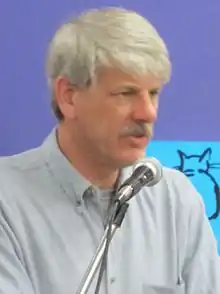Guy McPherson
Guy R. McPherson is an American scientist, professor emeritus[2] of natural resources and ecology and evolutionary biology at the University of Arizona.[3][4] He is known for the idea of Near-Term Human Extinction (NTHE), a term he coined[4] about the likelihood of human extinction by 2026.[5][6][7]
Guy R. McPherson | |
|---|---|
 | |
| Education | BS, University of Idaho (1982)
MS, Texas Tech University (1984) PhD, Texas Tech University (1987)[1] |
| Alma mater | University of Idaho |
| Website | Official website |
Biography
McPherson's career as a professor began at Texas A&M University, where he taught for one academic year. He taught for twenty years at the University of Arizona,[8] and also taught at the University of California-Berkeley, Southern Utah University, and Grinnell College. McPherson has served as an expert witness for legal cases involving land management and wildfires.[9] He has published more than 55 peer-reviewed publications.[10] In May 2009, McPherson began living on an off-grid homestead in southern New Mexico. He then moved to Belize in July 2016. He moved to New York in October of 2018.[11]
In November 2015, McPherson was interviewed on National Geographic Explorer with host Bill Nye.[12] Andrew Revkin in The New York Times said McPherson was an "apocalyptic ecologist ... who has built something of an 'End of Days' following."[12] Michael Tobis, a climate scientist from the University of Wisconsin, said McPherson "is not the opposite of a denialist. He is a denialist, albeit of a different stripe."[13] David Wallace-Wells writing in The Uninhabitable Earth (2019) called McPherson a "climate Gnostic" and on the "fringe,"[14] while climate scientist Michael E. Mann said he was a "doomist cult hero."[15]
Publications
- McPherson, G.R., D.D. Wade, and C.B. Phillips (compilers). 1990. Glossary of Fire Management Terms Used in the United States. Society of American Foresters, Bethesda, Maryland.
- McPherson, G.R. 1997. Ecology and Management of North American Savannas. University of Arizona Press, Tucson.
- McPherson, G.R. and S. DeStefano. 2003. Applied Ecology and Natural Resource Management. Cambridge University Press, Cambridge, England.
- Weltzin, J.F. and G.R. McPherson (editors). 2003. Changing Precipitation Regimes and Terrestrial Ecosystems. University of Arizona Press, Tucson.
- McPherson, G.R. 2004. Killing the Natives: Has the American Dream Become a Nightmare? Whitmore Publishing Company, Pittsburgh, Pennsylvania.
- McPherson, G.R. 2006. Letters to a Young Academic: Seeking Teachable Moments. Rowman & Littlefield Education, Lanham, Maryland.
- Brothers, Mac. 2006. Academic Pursuits. PublishAmerica, Baltimore, Maryland.
- Jensen, S.E. and G.R. McPherson. 2008. Living with Fire: Fire Ecology and Policy for the Twenty-first Century. University of California Press, Berkeley.
- Esparza, A.X. and G.R. McPherson (editors). 2009. The Planner's Guide to Natural Resource Conservation: The Science of Land Development Beyond the Metropolitan Fringe. Springer, New York.
- McPherson, G.R. 2011. Walking Away from Empire: A Personal Journey. PublishAmerica, Baltimore, Maryland.
- McPherson, G.R. 2013. Going Dark. PublishAmerica, Baltimore, Maryland.
- Baker, C. and G.R. McPherson. 2014. Extinction Dialogs: How to Live with Death in Mind. Tayen Lane Publishing.
- Schneider, P. and G.R. McPherson. 2015. Ms. Ladybug and Mr. Honeybee: A Love Story at the End of Time. America Star Books, Baltimore, Maryland.
- McPherson, G.R. 2019. Only Love Remains: Dancing at the Edge of Extinction. Woodthrush Productions, Pleasantville, New York.
- McPherson, G.R. 2019. "Becoming Hope-Free: Parallels Between Death of Individuals and Extinction of Homo sapiens" Clinical Psychology Forum, No 317, May 2019.
References
- https://cals.arizona.edu/~grm/history.html
- "Chances high for another dry winter in Monterey County". The Salinas Californian. Retrieved 15 May 2019.
- Guy M. McPherson. "Guy R. McPherson Faculty Page". University of Arizona. Retrieved July 10, 2016.
- Nathan Curry (August 21, 2013). "Humanity Is Getting Verrrrrrry Close to Extinction". Vice.com. Retrieved July 10, 2016.
- Jamail, Dahr. "Mass Extinction: It's the End of the World as We Know It". Truthout. Retrieved 6 July 2015.
- Richardson, John H. "When the End of Human Civilization is your Day Job". Esquire. Retrieved 7 July 2015.
- Anna Majavu (November 6, 2014). "Africa: Climate Change No Longer Linear". AllAfrica.com. Retrieved July 10, 2016.
- "Guy R. McPherson Faculty Page: Academic History". University of Arizona. Retrieved May 14, 2019.
- Guy M. McPherson. "Guy R. McPherson Faculty Page: Services". University of Arizona. Retrieved July 10, 2016.
- "Refereed Journal Articles - Guy R. McPherson". cals.arizona.edu.
- "What I Live For". weeklyhubris.com.
- Andrew Revkin (October 31, 2015). "National Geographic Explores Bill Nye's Climate Change Denial – and Arnold Schwarzenegger's Analysis". The New York Times. Retrieved July 10, 2016.
- Michael Tobis (March 13, 2014). "McPherson's Evidence That Doom Doom Doom". Planet3.0. Retrieved July 10, 2016.
- Roger Pielke (March 8, 2019). "The Uninhabitable Earth — future imperfect". Financial Times. Retrieved May 14, 2019.
We are introduced to Guy McPherson and Paul Kingsnorth, called “climate Gnostics” by Wallace-Wells, both of whom have dropped out of society to await the climate rapture. It seems that Wallace-Wells introduces these “fringe” characters to normalise his own apocalyptic vision, as if to say: You think I’m out there? Look at these guys.
- Michael E. Mann (July 12, 2017). "Doomsday scenarios are as harmful as climate change denial". Retrieved May 14, 2019.